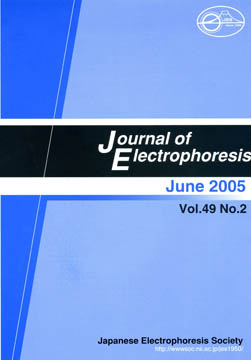The utility of an automated 96-capillary electrophoresis instrument equipped with a laser-induced fluorescence detector was evaluated in the analysis of affinophoresis using concanavalin A and trypsin as models. Affinophores for concanavalin A and trypsin were prepared by coupling the affinity ligands,
p-aminophenylmannoside and
p-aminobenzamidine to soluble succinylpolylysine, respectively at a density of about 1/5 of the carboxyl groups. A dual buffer system, 60 mM borate-Na (pH 9.35) as an electrophoresis buffer and 60 mM 3-morpholinopropanesulfonic acid-Na (pH 7.35) containing 0.1% Tween 20 as a sample buffer, was employed to allow the interactions to occur at a physiological pH and also to maintain a high level of electroosmosis and reproducibility in the bare silica capillaries. The electrophoresis of the fluorophore-labeled proteins was carried out in the presence of affinophores, and changes in the mobility of the labeled proteins were analyzed in terms of the mobility moment, which represents the average mobility of the proteins, thus permitting the dissociation constants for the protein-affinophore interactions to be determined. The affinophoresis system was then used to evaluate the extent of binding of low molecular mass compounds based on the inhibition of the affinophoresis. In combination with the mobility moment analysis and the dual buffer system, the multi-capillary electrophoresis instruments proved to be useful for the analysis of biomolecular interactions by electrophoresis.
View full abstract
